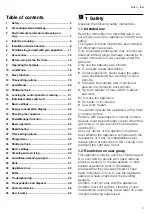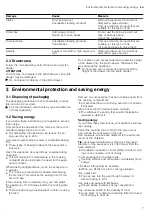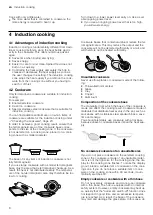
en
Induction cooking
8
Cook with only a little water.
¡
The more water that is contained in cookware, the
more energy is required to heat it up.
Turn down to a lower power level early on. Use a suit-
able ongoing power level.
¡
If you use an ongoing power level that is too high,
you will waste energy.
4 Induction cooking
4.1 Advantages of induction cooking
Induction cooking is fundamentally different from tradi-
tional cooking methods, since the heat builds up dir-
ectly in the cookware. This offers numerous advant-
ages:
¡
Saves time when boiling and frying.
¡
Saves energy.
¡
Easier to care for and clean. Spilled food does not
burn on as quickly.
¡
Controlling the heat supply and safety; the hob in-
creases or decreases the heat supply as soon as
the user changes the setting. The induction cooking
zone stops the heat supply if you remove the cook-
ware from the cooking zone without you having to
switch it off first.
4.2 Cookware
Only ferromagnetic cookware is suitable for induction
cooking.
For example:
¡
Enamelled steel cookware
¡
Cast iron cookware
¡
Special stainless steel cookware that is suitable for
induction cooking
You can find additional information on which items of
cookware are suitable for the induction cooking under
→
"Checking the cookware", Page 23
In order to achieve a good cooking result, ensure that
the ferromagnetic area of the cookware base corres-
ponds to the size of the cooking zone. If the cookware
is not detected on a cooking zone, place it on a cook-
ing zone with a smaller diameter.
The base of many items of induction cookware is not
fully ferromagnetic:
If you use large cookware with a smaller ferromagnetic
base, only the area that is ferromagnetic heats up. As a
result, the heat is not distributed evenly. The temperat-
ure of the non-ferromagnetic area may therefore be too
low for cooking.
Cookware bases that contain aluminium reduce the fer-
romagnetic area. This may reduce the output and the
cookware will not be detected sufficiently or at all, and
will therefore not be heated sufficiently.
Unsuitable cookware
Never use flow plates or cookware made of the follow-
ing:
¡
Thin-walled normal steel
¡
Glass
¡
Clay
¡
Copper
¡
Aluminium
Composition of the cookware base
The material(s) from which the base of the cookware is
made can affect the cooking result. Cookware made of
materials that distribute heat evenly in the pot, such as
saucepans with a stainless steel sandwich base, save
time and energy.
You should preferably use cookware with a flat base
because uneven cookware bases impair the heat sup-
ply.
No cookware/cookware of an unsuitable size
If you do not place cookware on the selected cooking
zone or the cookware is made of an unsuitable mater-
ial or is not the right size for the cooking zone, the dis-
play for the cooking zone flashes. To make the display
go out, place a suitable item of cookware on the cook-
ing zone. If you do not place a suitable item of cook-
ware on the cooking zone within 90 seconds, it auto-
matically switches off.
Empty cookware or cookware with a thin base
Do not heat empty cookware and do not use cookware
with a thin base. The hob is equipped with an internal
safety system. However, empty cookware may heat up
so quickly that the "Automatic switch-off" function does
not respond in good time and an excessive temperat-
ure is reached. As a result, the base of the cookware
may melt and damage the glass plate. In this case, do









































